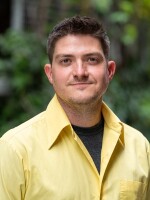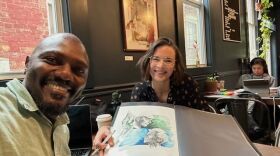In a church near Atlanta, singers eagerly cracked open the spines of their brand new “The Sacred Harp” songbooks, which they got just minutes ago. Details like design of the cover were kept secret until now. People filled in the pews with excited chatter, and hugs are exchanged between friends from this widespread, but close-knit community.
“I am overwhelmed with joy,” said Judy Mincey, an avid shape note singer. “A friend just described this as the world’s biggest family reunion.”
Then, David Ivey, head of the revision committee for the Sacred Harp Publishing Company, stepped up to a podium.
“Welcome to the celebration weekend for the debut of the ‘The Sacred Harp: 2025 Edition,’” he said, prompting a long, enthusiastic cheer from the crowd.
The music inside the book may look unusual to modern musicians. The notes are shapes that correspond with syllables like fa, sol and la. It was popular with Christians in the South during the 1800s because it taught untrained singers to read music. It stayed alive in rural parts of states like Tennessee, Kentucky, Alabama and Georgia.

Today, the songs are still sung with no rehearsal, no audience and no instruments. Even the religious aspect is optional. Although the themes are still pulled straight from scripture, many singers just enjoy the harmonies.
In a prepared speech, Ivey told the crowd that constant revision to “The Sacred Harp” is just as central to their community as the shape notes themselves. The revision committee added 113 new songs out of nearly 1,200 submissions from all over the world.
The last time this songbook was revised was in 1991, before the internet was widely used. And it’s thanks, in part, to the web that the shape note community has changed and grown quite a bit in recent years.
“This is our long history of groups of singers collaborating to produce our songbook [for] 176 years,” Ivey said. “This has served ‘The Sacred Harp’ well by involving caring revisers who understand and represent their singing brothers and sisters.”
The first day of the “celebration weekend” was scheduled for seminars to give singers background about the revision process to their beloved book.
But during a lunch break, singers were so eager to try the tunes out, a few dozen form an impromptu group outside.
“You can kind of feel how electric the air is, everybody is just so excited,” Jose Camacho-Cerna said, watching the group.
Camacho-Cerna has good reason to be excited, too. He wrote one of the new tunes in the book named “Lowndes,” after the county in Georgia where he lives.
He’s part of that younger crowd that’s found shape note singing in recent years. He said the dramatic lyrics, often about mortality and sin, and the simple-yet-powerful chords made it an easy transition from the music he was used to.

“I was in a punk band, [which] I know [sounds] kinda crazy,” he said. “That’s something that attracted me to it, I just thought it was very metal — the 1800s’ metal.”
Many of the singers like Camacho-Cerna came for the music but stayed for the community. It’s incredibly diverse. Here, women with short purple hair sing next to men with long white beards in four-part harmony.
“I love the singing, I love the community. Now, I get to be part of a historic legacy,” he said, with a grin. “So yeah, I’m quite happy.”
On Saturday, organizers estimate around 700 people showed up for the first official singing. It’s the largest gathering of shape note singers that anyone living can remember. Many weren’t sure if a singing this large would work or fall apart.
“The size is a little bit daunting to me,” Karen Willard said. “I normally wear hearing aids. Not today. I brought ear plugs.”
But judging by the smiles just a few songs into a weekend full of song, it worked well.
Ivey watched from behind the square of singers, wiping tears from his eyes. To him, “The Sacred Harp” is more than a collection of songs — it’s a symbol of unity.
“This book is precious to people. The book is what binds our community, the diaspora of singers everywhere,” he said. “The book — that’s what brings us together.”
Ivey said 50 years ago, people thought shape note singing was on its way out. But the update of “The Sacred Harp” keeps the book a living document.
This story was produced by the Appalachia + Mid-South Newsroom, a collaboration between West Virginia Public Broadcasting, WPLN and WUOT in Tennessee, LPM, WEKU, WKMS and WKU Public Radio in Kentucky and NPR.







